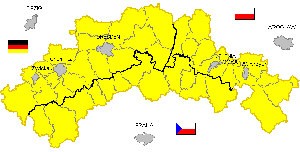 |
 |
|
1. Map of Black Triangle area. Please click to see enlarge! (132 K). Source: Inspectorate of Environmental Protection in Wroclaw. Branch Jelenia Gora.
|
|
 |
Air pollution: an international problem
Winds transport air pollutants from one place to another, even from one country to another. As a result, the impact of a particular pollutant may be felt far away from the emission source. A good example is the so-called "Black Triangle", an area located at the junction of the Polish, German and Czech borders. In this region there are three big lignite fields where brown coal is mined: Turoszow field, Lusatian field and North-Czech field, together with seven power plants producing 16,000 MWatts of energy. In 1989 this region, covering just 32,400 km2, was responsible for 30% of the total European emissions of SO2. These SO2 emissions contribute significantly to the acid rain problem (see the section on Areas endangered by acid rain).
Acid rain falling in this region caused the largest European event of mountain forest decay seen so far. Between 1981 and 1987, 11,000 hectares of spruce forest in the Sudety Mountains were damaged, of which 10,000 hectares were in the Western Sudety area. At the same time, 15,000 hectares of forest were destroyed in the North West Czech Republic and Saxony.
At the beginning of the 1990's co-operation between the three countries lead to action being taken to improve the natural environment. In 1992, an integrated network of 43 automatic monitoring stations was established in Poland, The Czech Republic and Germany and SO2 sources were reduced by modernising power plants and heating systems. Another factor which contributed to the improvement of air quality was the economic crisis and decrease in industrial production in Central European countries. As a result of all these factors, emissions of harmful substances decrease every year.
|







